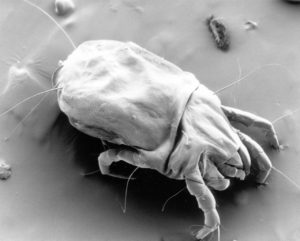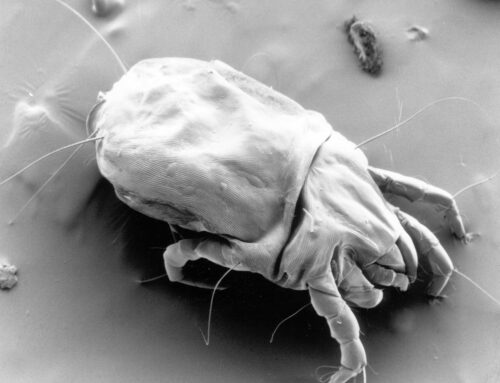Table of Contents
You’ve heard of dust mites and how these microscopic pests escaped your eyes. The mere imaginations of these ugly insects co-existing with you and actively feeding on dead skin cells can be frustrating. But how do you know for sure if you have dust mites lurking in your home?
What Are Dust Mites?

There are occasions where people felt they are being bitten by tiny insects when they’re sleeping. This can often be mistaken as a sign of dust mites but it’s not. Instead, dust mites don’t bite on human skins and the biting is often a sign of bed bugs instead.
Dust mites are tiny insects that are so small that they escape human eyes. To be exact, their body measures approximately 0.3 millimeters or 0.01 inch. A dust mite is 3 times smaller than the mint mark of a US quarter.
These microscopic bugs thrive in a humid and warm environment. They multiply and can grow rapidly in your home. But the real problems are not caused by the mite itself, but rather the excretion that is produced.
Dust mites feces contain a protein that can trigger allergic reactions in some people. Minor symptoms like coughing can escalate to nasal inflammation and in chronic cases, develops into asthma. It is a common problem in many households and can be the source of endless frustrations if you have children who have dust mites allergy.
How Do You Know If You Have Dust Mites At Home
As dust mites are so tiny that they escape your bare eyes, you’ll often question if dust mites are a rampant problem in your home, when you have episodes of an itchy throat. Here’s what you can do if you want to know if you have dust mites at home.
1. Use A Microscope

It’s time to recall the memories of using a microscope during your days at school. Get a microscope with at least 10x magnification power and collect samples of dust mites with an adhesive tape. If you are clueless about where to start, head over to your bedroom.
Your mattress has the highest population of dust mites (if any) as you spent around 8 hours sleeping on it. Imagine the number of dead skin cells that you’ve shed while you’re asleep. Chances are, millions of dust mites are happily existing in your mattress.
Besides the bedroom, collect samples from other suspect items, like carpets, rugs, curtains or areas that have trapped layers of dust. You can also place adhesive tape on your skin to obtain and dust mites that may have got on your body.
Place those samples on a microscope and if you’re lucky (or not), you’ll get a clear vision of dust mites. Expect creatures that look similar to a spider but much more hideous. A dust mite has 8 legs, no wings, no eyes and without any antennae.
You may also catch a glimpse of dust mites feces, which are small rectangular pellets that are brownish in appearance.
2. Use A Dust Mite Test Kit
It probably sounds unlikely but there are dust-mite test kits available. These are DIY solutions that require you to collect samples of dust by vacuuming and perform a series of tests on the samples.
Often, a reagent is applied to the sample and the resulting colors indicate the level of dust mites infestation in the particular sample. Here’s one of the cheapest dust mite test kit that you can get on Amazon.
You’ll get the results in 10 minutes on whether the level of dust mites in the samples is low, medium or high.
3. Identify Dust Mite Allergy Symptoms

You could be oblivious to the millions of dust mites growing rapidly in your home. But there’s no mistaking the allergy symptoms triggered by the tiny pests. In fact, the signs of allergy indicate that the number of dust mites has grown to a substantial amount.
Dust mites allergy often results in teary eyes, itchy throats, coughing and sneezing. If early symptoms are left untreated, you may find yourself having nasal inflammation. The nasal pathway will be swollen and it makes breathing uncomfortable.
If you have children suffering from dust mites allergy, you need to be diligent in addressing the symptoms, and more importantly, getting rid of the dust mites. Children with prolonged dust mites allergy risk developing asthma.
You can also perform a skin prick test in clinics to ascertain if you’re allergic to dust mites. The test involves pricking your skin with a small sample of dust mites and observe if you develop rashes or swell from the allergen.
What Should You Do If You’re Allergic To Dust Mites
If the allergy symptoms are posing a nuisance to your health, your doctor will prescribe the proper medications for you. Normally, the antihistamine will be prescribed to minimize the symptoms. A nasal spray is also often prescribed to minimize nasal congestion and related symptoms.
Talk to your doctor if you suspect you are suffering from dust mites allergy.
But treatment is only part of the solution. If the dust mites population is not reduced, the symptoms will relapse and you’ll have to continue the medications. I personally believe prolong usage of treatment does more harm than good.
You’ll need to start getting rid of dust mites from your home, or at least, reduce the growth rate of the bugs. It’s important to regularly wash and change your beddings to minimize the growth of dust mites in the mattress.
Vacuuming your home on a regular basis is also a good strategy in reducing the dust mites population. You may also want to invest in a special UV dust mites vacuum cleaner to remove dust mites from mattresses and cushions.
Check out more effective methods in getting rid of dust mites in this article.
Final Thoughts
Being aware of dust mites existing in your home helps you to understand what you’re facing. But it’s the constant discipline of keeping your home free of dust mites that are the best solution.
Do you have dust mites problem at home? What did you do to reduce the dust mites’ growth? Share your tips in the comment below.
Related:
- How To Remove Dust Mites From Home Naturally
- What Are Dust Mites – Get To Know The Unseen Pests
- Dust Mite Allergy Symptoms – Look Out For These Signs




Leave A Comment